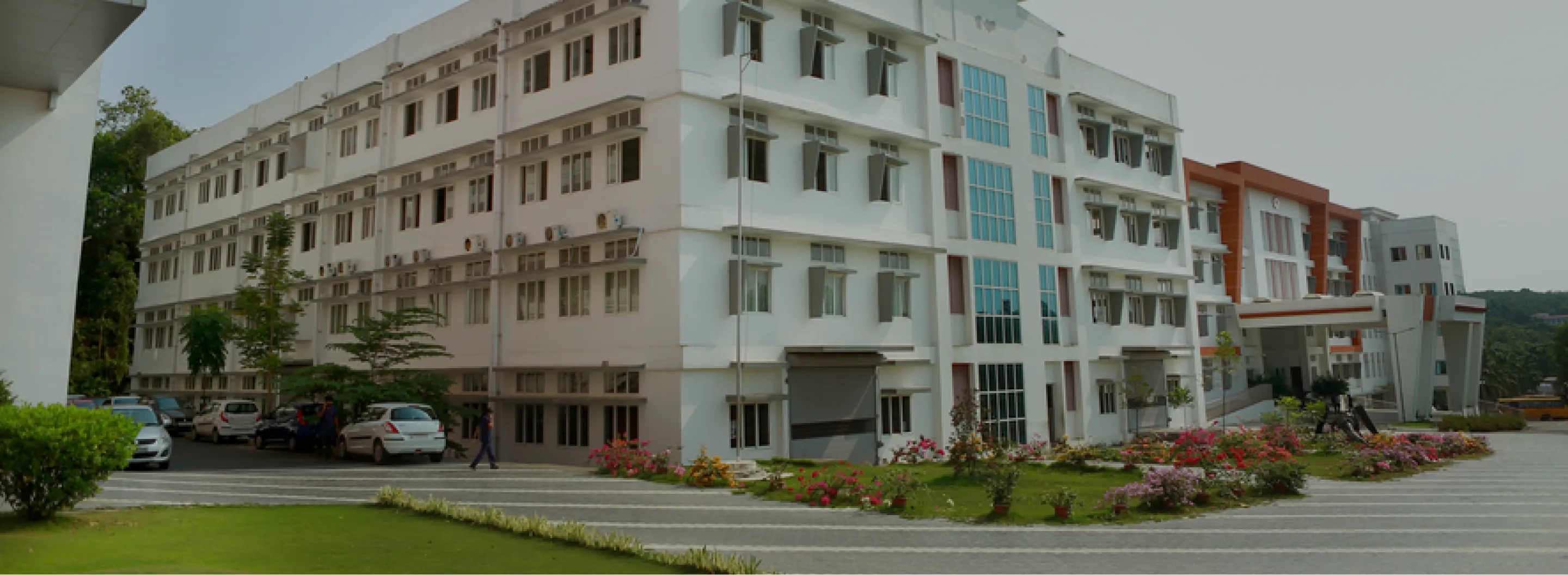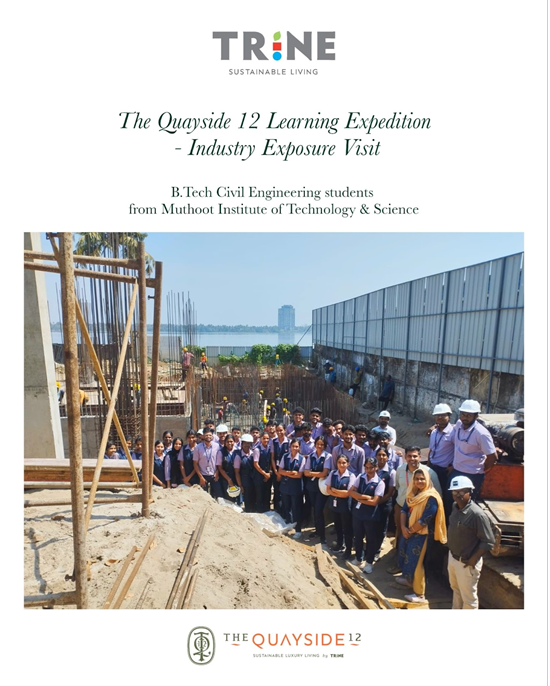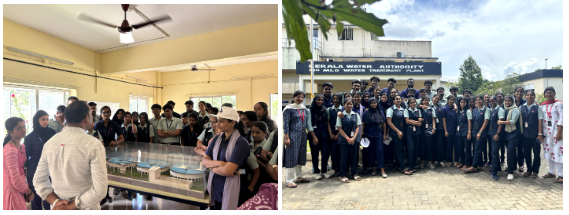
IMMERSION PROGRAM AT COCHIN SHIPYARD ORGANIZED BY L & T
S6CE: March 10, 2025
Faculty accompanied: Dr. Shaji M Jamal
Highlights and activities observed
Twenty-one top-performing students from the Civil, Mechanical, Electronics and Electrical Engineering departments, who successfully completed L&T Edutech courses, along with Dr. Shaji M. Jamal, Assistant Professor, CE Department, participated in an immersion program at Cochin Shipyard on March 10, 2025. The program was organized by L&T.
Activities at the time of visit were

VISIT TO KLAR KONKRETE RMC, THRIKKARIYOOR, KERALA
S4 CE : JAN 09 TH 2025
Faculty accompanied : Dr. Sandeep M S. & Mr. Binol Varghese
Highlights and activities observed.
The visit to KLAR KONKRETE provided students with an opportunity to witness centralized concrete mixing and post-tensioning processes for KSEB electric poles. The automated batching of cement, aggregates, water, and admixtures was explained in detail, highlighting the precision and quality control involved in ready-mix concrete production. Additionally, the manufacturing of prestressed concrete poles through post-tensioning techniques, which ensures higher durability and strength, was demonstrated. The exposure to advanced machinery and computerized control systems emphasized the role of technology in achieving efficiency and sustainability in modern construction practices.
Activities at the time of visit were

VISIT TO MULTI STOREY APARTMENT, QUAYSIDE 12, TRINE GROUP , EDAKOCHI – S6 CE : JAN 27TH 2025
Faculty accompanied : Ms. Jereena Jawahar & Mr. Daniel A.V
Highlights and activities observed.
A multi storey apartment project with 13 floors at Edakochi was the construction site visited by the third year students. Common areas are designed with a commitment towards Net-Zero carbon and energy goals, maximizing solar power and promoting resource efficiency, aiming for IGBC Green Building certification. The Quayside 12 offers luxurious amenities like an infinity pool, Jacuzzi, and open deck lounge, all set against the lush backwaters, creating a sanctuary where every detail is crafted for a luxuriously serene escape, leaving a minimal environmental footprint for generations to come. Usage of GGBS in the mix design of concrete to attain better sustainability and the nature of strength gain for the concrete was explained in detail.
Activities at the time of visit were

VISIT TO WATER TREATMENT PLANT, MARADU- S7 CE : OCT 9TH 2024
Faculty accompanied : Ms. Rija Johny, Ms. Minnie Mariya James
Highlights and activities observed.
S7 CE batch students had a site visit to KWA,Maradu on October 9,2024. They were introduced to the detailed water treatment process and all the components essential for the treatment were familiarized. The process of backwashing was illustrated in detail.
Activities at the time of visit were

VISIT TO AUDITORIUM CONSTRUCTION SITE, PATTIMATTOM- S5 CE : OCT 5TH 2023
Faculty accompanied : Dr. Kannan C. Bhanu & Mr. Daniel A.V
Highlights and activities observed.
Guides described about construction of 2 storey auditorium building near Pattimattom. They mainly explained detailing of ties, stirrups, reinforcement bars, columns and beams. They also explained about the construction details of retaining walls, formwork erection details along with the layout plan of the auditorium.
Activities at the time of visit were

VISIT TO MUTHOOT GROUP CORPORATE OFFICE CONSTRUCTION SITE. ERNAKULAM – S6 CE : MAR 28TH 2023
Faculty accompanied : Mr. Daniel A. V. and Ms. Ginu S Malakeel
Highlights and activities observed.
The office is a 11 storeyed RCC Frame building , with 2 level basement for parking each 3m below Ground level and a total area of 2 lakh sq.ft. Two sump tanks are provided on either side of the ramp towards the basement with capacity of 2 lakh liters of water required to meet fire demand of the building. The pump for the same is installed beneath the ramp. The foundation consists of rotary piles 33m deep, socketed into the base rocks. Water table is available at 1m below ground level, seepage of water through floors are prevented by pressure grouting into the voids in soil. Post – tensioned (PT) beams are provided in the basement. RC Shear walls are provided as lift shaft walls for lateral load resistance. A 10 m long cantilever canopy is provided, one end of which is pin jointed to the building frame, while the other end is suspended from the columns of the top floor using ties. An architectural facade is provided made using a material imported from Italy, similar to granite but having lesser weight, making it safer to be used for construction in high rises.
Activities at the time of visit were

VISIT TO METROLA STEELS, MUVATTUPUZHA – S3 CE : NOV 14TH 2023
Faculty accompanied : Mr. Shaji M Jamal & Ms. Serin Sara Roy
Highlights and activities observed.
Guides described the manufacturing process of METCON TMT steel bars. Derivatives of iron ore like sponge iron, Ferro alloys etc are used to cast high quality billets.These billets are rolled in 25 different stages to steel bars of 8mm,12mm,16mm 20mm and 25mm sizes through PLC assisted SCADA controlled automated plant. This automated technology was implemented with the help of FUJI Japan which relies on precision and consistent accuracy.
Activities at the time of visit were

VISIT TO QCRETE READY MIX PLANT, AMBALAMUGAL – S6 CE : DEC 6TH 2022
Faculty accompanied : Mr. Jereena Jawahar & Ms. Sruthy T.G
The site visit to the Qcrete Ready Mix Plant at Ambalamugal on December 6, 2022, provided an overview of the concrete production process and quality control measures. Key observations included the efficient handling and storage of raw materials, automated batching for precise ingredient proportioning, and the use of transit mixers for thorough mixing during transport. The plant’s on-site laboratory conducted slump and cube tests to ensure quality. Additionally, strict safety protocols and environmental measures were followed, emphasizing the plant’s commitment to operational safety and sustainability.
Activities at the time of visit were
Raw Material Handling
Batching Process
Mixing Process
Quality Control
Environmental and Safety Measures

VISIT TO KERALA WATER AUTHORITY 100 MLD WATER TREATMENT PLANT, MARADU – S7 CE : OCT 19TH 2023
Faculty accompanied : Ms. Ancy P Regi and Ms. Minnie Mariya James
Highlights and activities observed.
A visit to a water treatment plant reveals a detailed process designed to ensure safe drinking water. The journey begins with raw water intake, where debris is removed through screening. Next, coagulation and flocculation processes help clump together fine particles, which then settle in large basins during sedimentation. The water undergoes filtration through sand, gravel, and activated carbon to eliminate remaining impurities. Disinfection, often through chlorination or UV treatment, kills harmful microorganisms, making the water safe for consumption. The treated water is stored in large tanks before being distributed to homes and businesses. Operators monitor these processes in a control room, ensuring everything runs efficiently. The plant also manages sludge byproducts, treating and disposing of them responsibly. Regular laboratory testing guarantees water quality, while energy efficiency and waste management practices minimize the environmental impact. The entire operation is a testament to the complex systems required for clean, safe drinking water. The major process used for treating 100 MLD water treatment plant is the Activated Sludge Process.

VISIT TO CHELLANAM (TETRAPOD CONSTURCTION AND LAYING) – S7 CE : FEB 24TH 2023
Faculty accompanied: Mr. Jereena Jawahar & Ms. Sruthy T.G
Highlights and Activities Observed
The site visit to Chellanam on February 24, 2023, focused on the construction and laying of tetrapods as part of coastal protection efforts. The visit highlighted the importance of tetrapods in preventing coastal erosion and safeguarding the shoreline from strong waves. Activities observed included the casting of tetrapods using reinforced concrete, where the molds and reinforcement techniques were explained. The process of curing and transportation of these tetrapods to the shoreline was demonstrated, followed by the precise method of placing them along the coast to dissipate wave energy. The visit emphasized the engineering and logistical challenges involved in coastal protection projects.
Activities at the time of visit were
Tetrapod Casting
Curing Process
Transportation
Tetrapod Placement
Discussion on Coastal Erosion

VISIT TO IDUKKI DAM – S5 CE : JUL 23RD 2022
Faculty accompanied : Mr. Jereena Jawahar & Ms. Sruthy T.G
The site visit to Idukki Dam on July 23, 2022, provided an insightful look into one of India’s largest arch dams, focusing on its structural and operational aspects. The visit highlighted the dam’s critical role in hydroelectric power generation and water management in Kerala. Activities observed included a detailed explanation of the dam’s design, its reservoir capacity, and the mechanisms used for controlling water flow. The group also learned about the safety measures in place for monitoring the dam’s structural integrity and its contribution to flood control. The visit underscored the dam’s significance in regional power supply and water conservation.
Activities at the time of visit were
